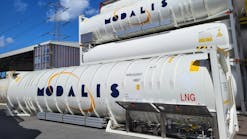Leaders from the Clean Freight Coalition (CFC) met with officials from the Joint Office of Energy and Transportation last week to discuss the challenges and opportunities of transitioning the nation’s commercial truck fleet to low- and zero-emission vehicles.
Their first meeting comes as emerging state and federal regulations aim to push the transportation sector toward decarbonization.
During the July 26 meeting, CFC urged the Joint Office—which was created by the Bipartisan Infrastructure Law to facilitate collaboration between the U.S. Departments of Energy and Transportation on deploying electric vehicle chargers and zero-emission fueling infrastructure—to consider the heavy-duty sector when granting federal funds. CFC cites a massive infrastructure gap as one of the largest hurdles to a seamless transition away from carbon-based fuels—one that policymakers need to focus on now, CFC says.
“The entire transportation ecosystem is at risk,” Ryan Streblow, National Tank Truck Carriers president and CEO, stated in a news release.
“The tank truck industry envisions low- and zero-emission commercial trucks, but current timelines and goals must account for technology availability, affordability, infrastructure overall—and a scalable energy source.”
Jim Mullen, CFC executive director, pointed the “fatal flaws” in California’s electric-truck mandates, including an infrastructure buildout that is “light years” behind the “hyper-aggressive” timelines fleets are facing.
“By trying to force the trucking industry to electrify without the charging infrastructure and power capacity that will be required, the state is setting trucking and the supply chain up for failure,” he said. “That's why in our meeting with the Joint Office [last week] we stressed why EPA should not propose ZEV-dependent rules prior to ensuring the necessary resources are actually in place.”
See also: New trucking coalition looks to set realistic decarbonization path
In order to realize the scalable deployment of medium- and heavy-duty battery-electric trucks envisioned by EPA’s GHG3 rulemaking, 15,625 chargers would have to be installed every month between now and 2032, according to a Ricardo analysis. To date, no state has directed any National Electric Vehicle Infrastructure (NEVI) grant program funds to medium- and heavy-duty charging infrastructure.
For charging to be compatible with complex truck driving schedules, charging will have to take place at existing truck parking locations along interstate routes, yet the industry already faces a chronic, nationwide shortage of commercial truck parking.
“We need to get this right, which frankly the consequences are too great,” said Dan Van Alstine, chairman of the American Trucking Associations, and president and chief operating officer at Ruan Transportation Management Systems. “It’s critical that any regulatory framework is connected to the realities of trucking operations.
“That is the key to success, and that is why we are here in Washington having these conversations.”
The meeting also included representatives from the American Truck Dealers, Truckload Carriers Association, and National Motor Freight Traffic Association.
“Policies shouldn’t ignore the lower-carbon fuels that are at our disposal today,” added Andy Richard, Sapp Bros. CEO. “A market-driven, technology-neutral approach will advance the adoption of alternative fuels without picking winners and losers. Biodiesel and renewable diesel represent the best option that fleets have today to reduce their carbon emissions, and this will be the case for the foreseeable future.
“The right policies will encourage fuel retailers to make these investments without sacrificing efforts on electrification, hydrogen, or other next-generation fuels.”









